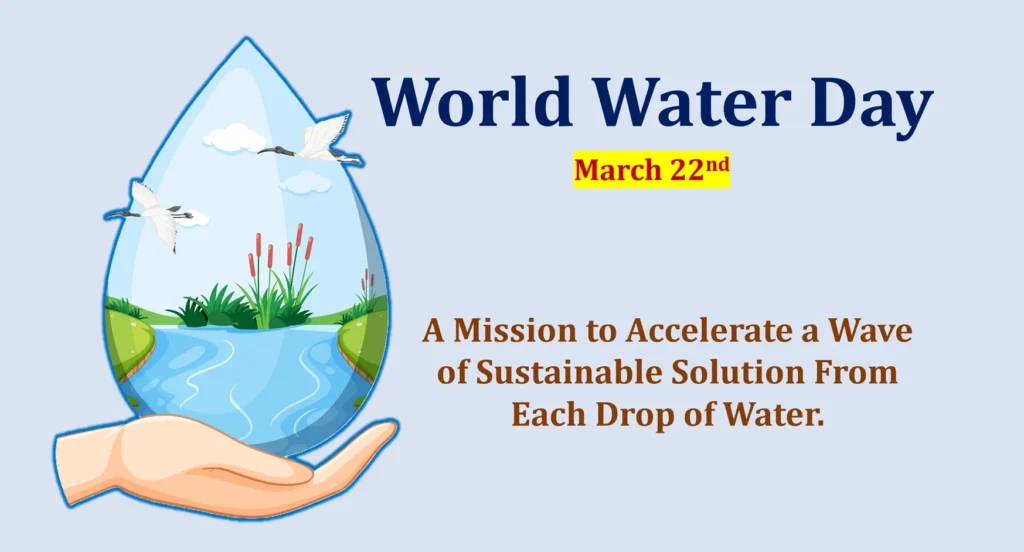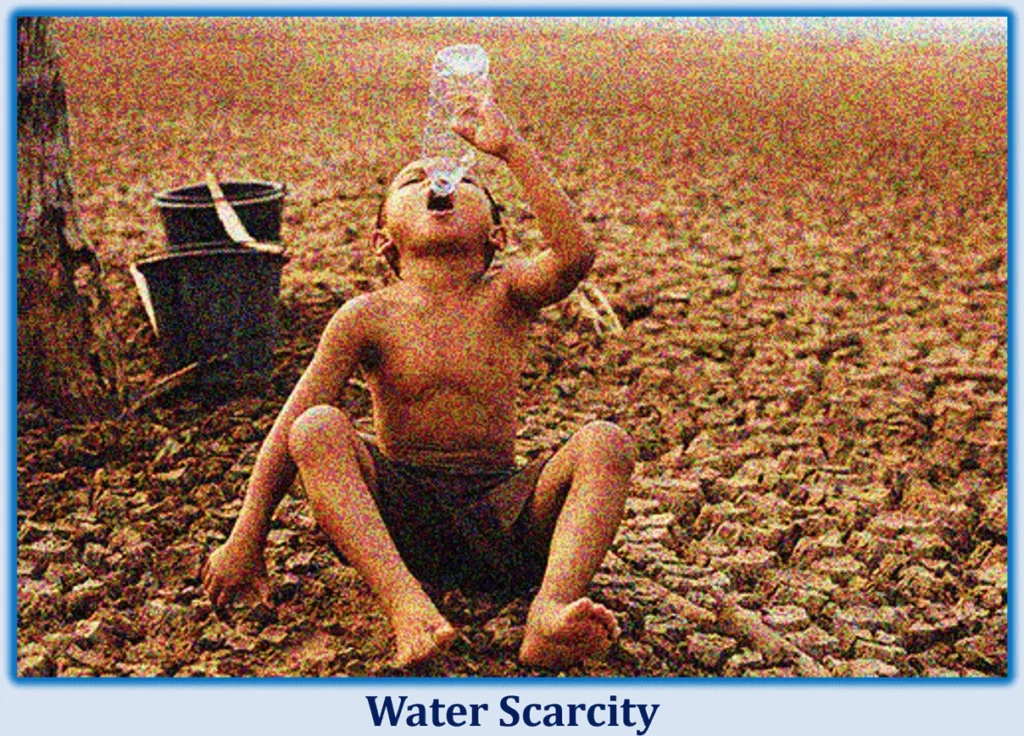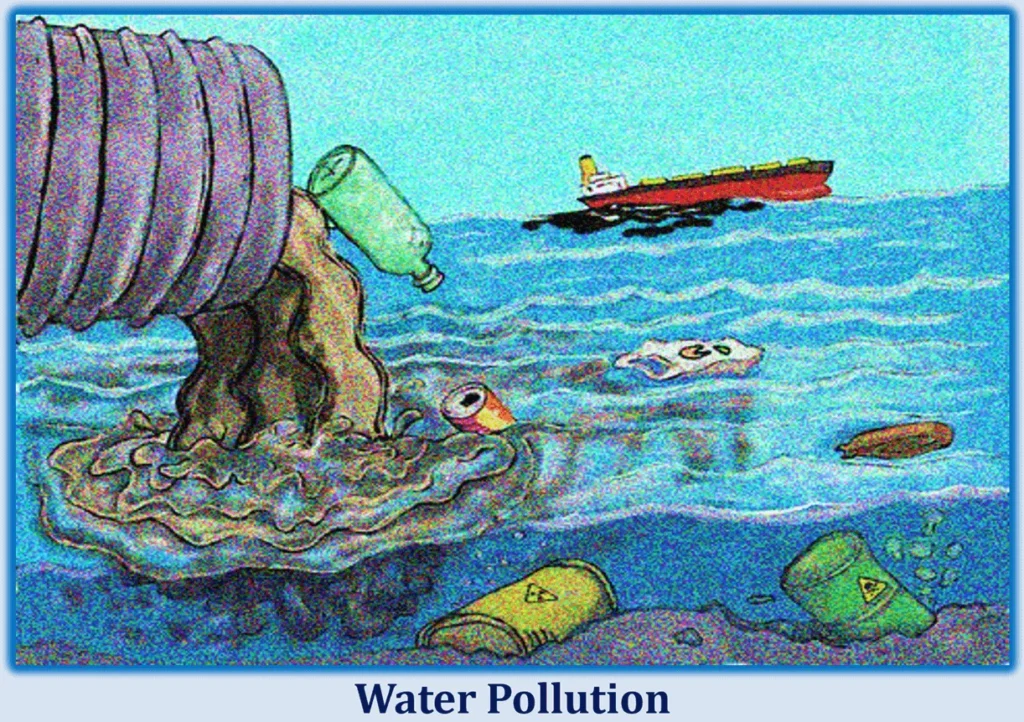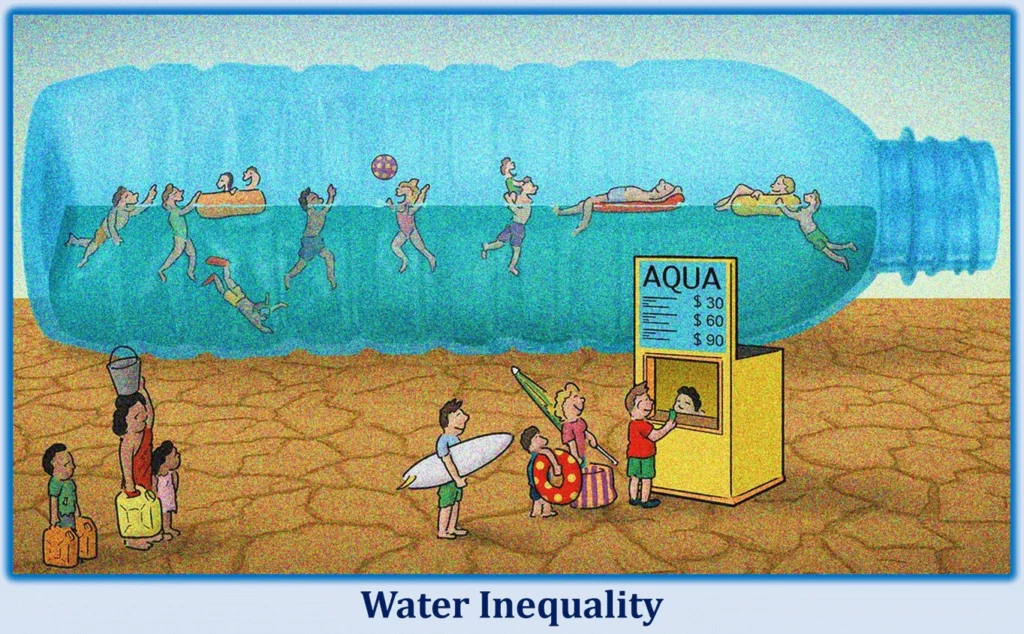
Introduction
What is World Water Day?
Every year on March 22, the world observes World Water Day, a day to promote sustainable water resource management and increase public awareness of the value of freshwater. It serves as a platform to highlight the significance of water in various aspects of human life, from health and sanitation to agriculture and industry. Recognized by the United Nations, World Water Day aims to address water-related challenges and promote actions that ensure the availability and sustainable management of water for all.
History of World Water Day
World Water Day was first proposed at the 1992 United Nations Conference on Environment and Development (UNCED) in Rio de Janeiro, Brazil. Following this, the United Nations General Assembly designated March 22nd as World Water Day, starting in 1993. Since then, it has been observed annually, each year with a specific theme focusing on various aspects of water-related issues. The themes often revolve around topics such as water scarcity, water quality, water conservation, and equitable access to water resources.
Importance of Raising Awareness about Water-Related Issues
Raising awareness about water-related issues is paramount due to water’s essential role in sustaining life and ecosystems. Access to clean water is fundamental for human health, sanitation, and hygiene, yet millions still lack it, leading to waterborne diseases and economic hardships. Moreover, water scarcity and pollution, exacerbated by factors such as population growth and climate change, present significant challenges globally. By shedding light on these issues on World Water Day, individuals and organizations can advocate for equitable access to clean water and promote sustainable management practices. Through dialogue and collaboration, stakeholders can address these challenges effectively.
Furthermore, promoting water conservation and pollution reduction empowers individuals to take action in their daily lives. Raising awareness fosters a collective commitment to safeguarding water resources, ensuring that everyone has access to this vital resource for their well-being and the health of the planet.
“Water is the driving force of all nature.”
– Leonardo da Vinci
The Significance of Clean Water
Essential Role of Water in Human Life
Water is the cornerstone of life, playing a vital role in various bodily functions and essential processes. It constitutes a significant portion of the human body and is involved in digestion, circulation, temperature regulation, and nutrient transport. Without an adequate intake of water, the body cannot function optimally, leading to dehydration, fatigue, and other health issues. Furthermore, water is essential for food production, as it is necessary for irrigating crops and sustaining livestock. In communities worldwide, access to clean water is essential for cooking, cleaning, and maintaining personal hygiene, highlighting its indispensable role in daily life.
Impact of Clean Water on Health, Sanitation, and Hygiene
Clean water is paramount for maintaining good health and preventing waterborne diseases. Access to safe drinking water and proper sanitation facilities is critical for reducing the spread of infectious diseases such as cholera, dysentery, and typhoid fever. Additionally, clean water is essential for maintaining proper hygiene practices, including handwashing, bathing, and food preparation. By ensuring access to clean water and sanitation, communities can significantly improve public health outcomes, reduce mortality rates, and enhance overall well-being.
Economic and Social Benefits of Access to Clean Water
Access to clean water brings about numerous economic and social benefits to communities and societies. Economically, clean water is essential for various industries, including agriculture, manufacturing, and tourism. Adequate water supplies enable agricultural productivity, support industrial processes, and drive economic development.
Moreover, access to clean water can lead to improved educational outcomes, particularly for girls who are often responsible for water collection in many regions. By reducing the time spent fetching water, individuals, especially women and children, have more opportunities for education, skill development, and economic participation. Additionally, access to clean water can contribute to social cohesion and stability within communities, as it fosters healthier and more prosperous living conditions for all members.
“Water is life’s matter and matrix, mother and medium. There is no life without water.”
– Albert Szent-Györgyi
Current Challenges in Water Management
Global Water Crisis
The global water crisis presents a multifaceted challenge characterized by scarcity, pollution, and inequality, impacting communities worldwide.

- Scarcity: Water scarcity occurs when demand exceeds the available supply, leading to inadequate access to clean water for drinking, sanitation, and irrigation purposes. Rapid population growth, urbanization, climate change, and unsustainable water management practices exacerbate water scarcity, particularly in arid and semi-arid regions.

- Pollution: Water pollution stems from various sources, including industrial discharge, agricultural runoff, improper waste disposal, and urban sewage. Contaminants such as chemicals, heavy metals, pathogens, and plastic debris degrade water quality, posing significant health risks to humans and ecosystems.

- Inequality: Access to clean water is unequally distributed, with marginalized and vulnerable populations disproportionately affected by water insecurity. Socioeconomic disparities, political conflicts, and inadequate infrastructure contribute to unequal access to safe water and sanitation services, perpetuating social injustice and exacerbating poverty cycles.
Factors Contributing to Water Scarcity and Pollution
Several interconnected factors contribute to water scarcity and pollution, including:
- Overexploitation: Unsustainable water extraction for agriculture, industry, and domestic use depletes groundwater reserves and reduces surface water availability.
- Climate Change: Alterations in precipitation patterns, increased temperatures, and more frequent extreme weather events exacerbate water scarcity and pollution, disrupting hydrological cycles and exacerbating droughts and floods.
- Population Growth and Urbanization: Rapid population growth and urbanization strain water resources, leading to increased water demand, pollution, and inadequate infrastructure to meet growing needs.
- Land Use Practices: Deforestation, land degradation, and improper land management contribute to soil erosion and runoff, contaminating water bodies with sediments, nutrients, and pollutants.
- Industrial and Agricultural Activities: Industrial discharge, chemical fertilizers, pesticides, and livestock farming contribute to water pollution, affecting both surface and groundwater quality.
Impacts on Communities, Ecosystems, and Economies
The challenges in water management have profound impacts on communities, ecosystems, and economies:
- Health Impacts: Waterborne diseases, such as diarrhea, cholera, and typhoid fever, result from contaminated water sources, leading to illness, mortality, and economic burdens on healthcare systems.
- Ecosystem Degradation: Water pollution harms aquatic ecosystems, depleting biodiversity, disrupting food chains, and impairing ecosystem services such as water purification, flood regulation, and nutrient cycling.
- Economic Losses: Water scarcity and pollution undermine agricultural productivity, industrial operations, and tourism, leading to economic losses, job displacement, and reduced livelihood opportunities.
- Social Disparities: Unequal access to clean water exacerbates social inequalities, disproportionately affecting marginalized communities, women, children, and indigenous populations, limiting their opportunities for education, health, and socio-economic development.
Addressing the current challenges in water management requires concerted efforts to promote sustainable water use, improve water governance, enhance pollution control measures, and ensure equitable access to clean water and sanitation services. Collaborative actions at local, national, and international levels are essential to mitigate the impacts of the global water crisis and build resilient and water-secure communities for the future.
“Water is a lifeline that binds us all together, it is more than just a resource. On World Water Day, let us commit to working together to preserve and protect this invaluable natural asset for generations to come.”
Solutions and Initiatives
Sustainable Water Management Practices
Implementing sustainable water management practices is crucial for addressing the challenges posed by water scarcity, pollution, and inequality. This involves adopting strategies that prioritize the efficient use and conservation of water resources while minimizing environmental impact. Examples of sustainable water management practices include:
- Water conservation measures such as reducing water wastage, implementing water-efficient technologies, and promoting water-saving behaviors.
- Integrated water resource management approaches that consider the interconnectedness of water sources, ecosystems, and human activities.
- Watershed management initiatives that aim to protect and restore natural habitats, prevent soil erosion, and maintain water quality.
- Rainwater harvesting and groundwater recharge techniques to capture and store rainwater for various purposes, including irrigation and groundwater replenishment.
Innovative Technologies for Water Purification and Conservation
Advancements in technology offer promising solutions for addressing water-related challenges, particularly in terms of purification and conservation. Innovative technologies for water purification and conservation include:
- Advanced water treatment processes such as membrane filtration, reverse osmosis, and ultraviolet disinfection, which can remove contaminants and ensure the provision of safe drinking water.
- Smart irrigation systems and precision agriculture technologies that optimize water use in agriculture by delivering the right amount of water to crops based on real-time data and environmental conditions.
- Water-efficient appliances and fixtures for residential, commercial, and industrial use, such as low-flow toilets, aerated faucets, and water-efficient washing machines, which help reduce water consumption.
- Water recycling and reuse systems that treat wastewater to a high standard for non-potable purposes such as irrigation, industrial processes, and toilet flushing, thereby reducing freshwater demand and minimizing wastewater discharge.
Community-Based Initiatives and Grassroots Movements
Community-based initiatives and grassroots movements play a vital role in raising awareness, mobilizing action, and fostering local solutions to water-related challenges. These initiatives often focus on empowering communities to take ownership of their water resources and implement sustainable practices. Examples include:
- Community-led water management committees and cooperatives that promote community participation in decision-making processes, resource allocation, and infrastructure development.
- Educational programs and awareness campaigns that engage community members, schools, and local organizations in learning about water conservation, sanitation, and hygiene practices.
- Indigenous and traditional knowledge systems that recognize the value of local wisdom in managing water resources sustainably and preserving cultural heritage.
Government Policies and International Collaborations
Effective water management requires supportive policies, regulations, and governance frameworks at the local, national, and international levels. Governments, together with international organizations, can facilitate cooperation, coordination, and investment in water-related initiatives. Key strategies include:
- Developing and implementing water governance frameworks that prioritize water security, equity, and sustainability.
- Establishing and enforcing regulations to protect water quality, prevent pollution, and ensure the equitable distribution of water resources.
- Investing in infrastructure projects for water supply, sanitation, and wastewater treatment to improve access to clean water and sanitation services.
- Facilitating international collaborations and partnerships to address transboundary water issues, share knowledge and best practices, and mobilize resources for global water security.
Addressing the complex challenges of water management requires a multifaceted approach that combines sustainable practices, innovative technologies, community engagement, and supportive policies. By implementing solutions and initiatives at various levels, we can work towards ensuring equitable access to clean water, protecting ecosystems, and building resilient communities in the face of water-related risks and uncertainties.
Individual Actions for Water Conservation
Water-saving Tips for Households and Businesses
Conserving water at the individual level is essential for reducing overall water consumption and mitigating the impacts of water scarcity. Here are some practical water-saving tips for households and businesses:
- Fix leaks promptly: Repairing leaky faucets, pipes, and toilets can prevent water wastage.
- Install water-efficient fixtures: Replace old toilets, faucets, and showerheads with water-saving models that use less water without sacrificing performance.
- Use appliances efficiently: Run full loads in the dishwasher and washing machine to maximize water efficiency and consider investing in energy-efficient appliances that use less water.
- Practice smart landscaping: Choose drought-resistant plants, mulch garden beds to retain moisture, and water outdoor plants during cooler times of the day to minimize evaporation.
- Collect rainwater: Install rain barrels or cisterns to capture rainwater for outdoor irrigation and gardening.
- Adopt water-saving habits: Turn off the tap while brushing teeth, shaving, or washing dishes, and take shorter showers to conserve water.
7.
Intelligent Use of Wastewater from RO
Water rejected by a Reverse Osmosis (RO) machine, often referred to as wastewater or brine, typically contains dissolved minerals, contaminants, and pollutants removed from the feed water during the purification process. While it may not be suitable for drinking or cooking, there are several eco-friendly ways to utilize this rejected water rather than letting it go to waste:
- Gardening and Plant Irrigation: One of the most common uses for RO reject water is for watering plants and gardens. While the rejected water may contain some minerals, it’s generally safe for most plants, particularly those that are not sensitive to salts. Direct the wastewater to your garden or use it to water outdoor plants, shrubs, or trees.
- Household Cleaning: You can use RO reject water for a variety of domestic cleaning jobs, like car washes, floor mopping, and outdoor surface cleaning. Its relatively high mineral content can even make it effective for cleaning certain surfaces like tiles or metal fixtures.
- Pet Watering: If you have pets, consider using the RO reject water to fill their water bowls or for cleaning pet-related items such as litter boxes or cages. Ensure that the water is safe for your specific pets and avoid using it if it contains any harmful substances.
- Flushing Toilets: Another way to utilize RO reject water is by diverting it to flush toilets. While this may not directly contribute to water conservation, it can help reduce the overall water consumption in your household, especially if you have a separate water line for flushing toilets.
- Outdoor Fountain or Pond: If you have an outdoor fountain or pond, consider using the RO reject water to fill or top them up. However, be cautious if you have fish or other aquatic life in your pond, as the mineral content of the reject water may affect them adversely.
- Reprocessing and Reuse: Some homeowners install additional filtration systems or treatment methods to reprocess RO reject water for other household uses. This might involve additional treatment steps such as carbon filtration or ion exchange to remove remaining contaminants before reuse.
Raising Awareness and Promoting Behavioral Changes
Raising awareness about the importance of water conservation and promoting behavioral changes is crucial for fostering a culture of water stewardship. Individuals can:
- Educate themselves and others about water conservation principles, practices, and the impacts of water scarcity.
- Lead by example: Practice water-saving behaviors in daily routines and encourage friends, family members, and colleagues to do the same.
- Participate in community events, workshops, and campaigns focused on water conservation and sustainability.
- Advocate for water-saving measures in workplaces, schools, and local government policies.
- Share information and resources on social media platforms to raise awareness and inspire others to take action.
Supporting Organizations and Campaigns
Many organizations and campaigns are dedicated to advancing water conservation efforts globally. Individuals can support these initiatives by:
- Donating funds or volunteering time to organizations working on water conservation projects, research, and advocacy.
- Participating in fundraising events, walks, or campaigns organized by water conservation nonprofits.
- Signing petitions and contacting policymakers to advocate for policies that prioritize water conservation and sustainability.
- Engaging with corporate partners and businesses that demonstrate a commitment to water stewardship through sustainable practices and initiatives.
- Joining online communities and networks focused on water conservation to share ideas, resources, and support for collective action.
Individual actions play a crucial role in water conservation efforts, from adopting water-saving habits at home and in businesses to raising awareness and supporting organizations dedicated to water conservation. By making conscious choices and working together, individuals can contribute to safeguarding water resources for current and future generations.
Future of Water Security
Emerging Technologies for Water Purification
Advancements in technology offer promising solutions for addressing water security challenges, particularly in the realm of water purification. Emerging technologies include:
- Nanotechnology: Nano-based materials and membranes can effectively remove contaminants from water, enhancing water treatment efficiency.
- Solar-powered desalination: Solar energy-driven desalination processes offer sustainable solutions for converting seawater or brackish water into freshwater.
- Advanced oxidation processes: Innovative oxidation techniques, such as electrochemical and photocatalytic methods, can degrade pollutants and pathogens in water, improving water quality.
- Atmospheric water harvesting: Atmospheric water generators extract moisture from the air to produce potable water, offering a decentralized approach to water supply in water-scarce regions.
- Bio-inspired filtration systems: Biomimetic filters mimic natural processes, such as plant xylem and mangrove roots, to purify water with minimal energy consumption.
Collaborative Efforts for Global Water Security
Achieving water security requires collaborative efforts at local, national, and international levels. Key collaborative initiatives include:
- Transboundary water management agreements: Collaborative frameworks facilitate cooperation among countries sharing water resources, promoting equitable allocation and sustainable management.
- Public-private partnerships: Collaborations between government agencies, businesses, and civil society organizations drive investment in water infrastructure, technology innovation, and capacity-building efforts.
- Knowledge sharing and capacity building: International platforms and networks facilitate the exchange of best practices, technical expertise, and resources to support water security initiatives in diverse contexts.
- Climate resilience and adaptation strategies: Collaborative efforts focus on integrating water management with climate change adaptation measures, such as resilient infrastructure, ecosystem restoration, and disaster risk reduction.
- Multilateral funding mechanisms: International financial institutions and donor agencies provide funding support for water security projects, leveraging resources and expertise to address water-related challenges effectively.
Policy Recommendations for Ensuring Water Sustainability
Effective policy frameworks are essential for ensuring water sustainability and resilience. Policy recommendations include:
- Integrated water resources management: Implementing holistic approaches that consider the interconnectedness of water sources, land use, and ecosystems to promote sustainable water use and conservation.
- Water governance reforms: Strengthening regulatory frameworks, institutions, and decision-making processes to enhance transparency, accountability, and stakeholder participation in water management.
- Water pricing and incentives: Implementing pricing mechanisms and economic incentives to promote efficient water use, encourage conservation behaviors, and fund water infrastructure investments.
- Risk-based planning and management: Incorporating climate change adaptation, disaster risk reduction, and ecosystem-based approaches into water planning and management strategies to build resilience against water-related risks.
- Cross-sectoral coordination: Promoting coordination and collaboration among sectors such as agriculture, energy, and urban development to optimize water use, minimize conflicts, and maximize co-benefits.
Conclusion & FAQs
World Water Day serves as a reminder of the critical importance of water in sustaining life, ecosystems, and economies. It provides an opportunity to raise awareness about water-related challenges and mobilize action for water conservation and management.
As we commemorate World Water Day, let us renew our commitment to conserving and managing water resources sustainably. Each individual, community, and organization have a role to play in safeguarding water for current and future generations.
Together, we can make a difference by spreading awareness, advocating for policy reforms, supporting innovative technologies, and fostering collaboration for water security. Let us work towards a future where clean water is accessible to all, ensuring a healthier and more sustainable world for everyone.
Frequently Asked Question (FAQs)
What is the significance of World Water Day, and why is it celebrated annually?
Every year on March 22, the world observes World Water Day to promote the sustainable management of water resources and to increase public awareness of the value of freshwater. It highlights the critical role of water in various aspects of human life, including health, sanitation, agriculture, and industry, and serves as a platform to address water-related challenges globally.
What are the main objectives of World Water Day?
The main objectives of World Water Day are to raise awareness about water-related issues, promote actions to address water scarcity and pollution, advocate for equitable access to clean water for all, and foster dialogue and collaboration among stakeholders to ensure sustainable water management practices.
How does water scarcity impact different regions around the world?
Water scarcity affects different regions in various ways, including reduced access to clean water for drinking and sanitation, compromised agricultural productivity, increased competition for water resources among different sectors, and heightened vulnerability to droughts and climate change impacts.
What are some innovative solutions and technologies being developed to address water-related issues?
Innovative solutions and technologies for addressing water-related issues include advanced water treatment processes, water recycling and reuse systems, smart irrigation technologies, rainwater harvesting techniques, and decentralized water supply systems powered by renewable energy sources.
How can individuals contribute to water conservation efforts in their daily lives?
Individuals can contribute to water conservation efforts by adopting water-saving habits such as fixing leaks, using water-efficient fixtures, reducing water wastage, practicing responsible water use in daily activities, and supporting water conservation campaigns and initiatives.
What role do governments and policymakers play in ensuring access to clean water for all?
Governments and policymakers play a crucial role in ensuring access to clean water for all by developing and implementing water governance frameworks, enacting and enforcing regulations to protect water quality and ensure equitable access, investing in water infrastructure and services, and promoting water conservation and sustainability initiatives.
How does World Water Day contribute to raising awareness and mobilizing action on water-related issues at both local and global levels?
World Water Day contributes to raising awareness and mobilizing action on water-related issues by organizing events, campaigns, and activities focused on different aspects of water management and conservation, fostering dialogue and collaboration among stakeholders, showcasing innovative solutions and best practices, and advocating for policy reforms and investments in water security and sustainability.
